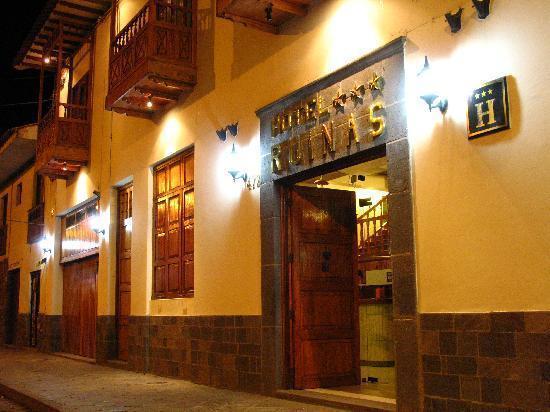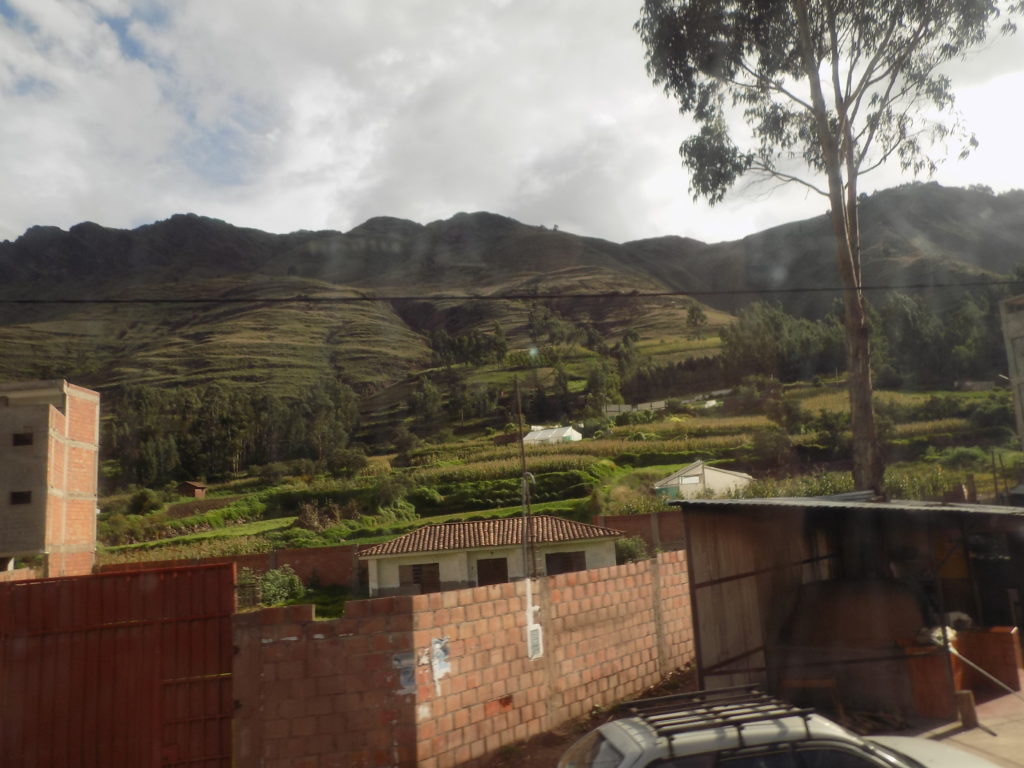Worthy of Spain.
It’s been estimated that in 1532 when the the Spaniards arrived, 40,000 people inhabited the city of Cusco proper with another 200,000 in the surrounding district.
They entered a planned city filled with typical Inka architecture – rectangular buildings with thatched roofs but without interior walls. Nearly all their buildings – from peasant homes to palaces and temples – adhered to this simple shape. Where there were walls, any openings in them were trapezoidal.
Among the most common Inkan structures was the kancha – a composite complex of three or more rectangular buildings symmetrically surrounding a central courtyard.

[Image of kanchas from Pinterest Ancient Architecture pin by Kevin Eoghan.]
Several kanchas could be grouped together to form a block in Inkan settlements. The expertise and masonry skills for which the Inka are deservedly famous was immediately apparent to the Spaniards. Refining the stoneworking skills they had seen at Tiwanaku, the Inkas used a type of masonry called ashlar in which each individual stone is worked until it is squared. Of course, the workers also fit the blocks together with no mortar.
Not only was the workmanship remarkable but the opulence was as well. It’s said that the walls of Qorikancha were covered in sheets of gold and that the courtyard was filled with golden statues. It’s little wonder, then that Pedro Sancho de la Hoz, secretary to Francisco Pizarro, wrote in 1534,
The city of Cusco is the principal one of all the cities and is the residence of the nobles, and is so great and beautiful that it would be worthy of Spain.
(A last peek out the bus window before our arrival in Cusco.)
Jill saves the day – or night.
We arrived in Cusco and transferred smoothly from the bus to our hotel which had the rather unappealing name Hotel Ruinas via a short ride in a van. As it turns out, it’s a lovely hotel on a narrow cobblestone street perhaps half a kilometer walk from the Plaza de Armas and draws its name from the street it occupies not the state of the hotel. At 3,400 meters, Cusco is still at twice the elevation of Denver, America’s Mile High City. However, at 3,400 meters it’s also some 400 meters closer to sea level than Puno and Lake Titikaka. Although we wouldn’t walk much that night, I’d find that the combination of the five previous days in the high Andes and the somewhat lower elevation of Cusco made walking more easily manageable than it had been to that point and, I suspect, more manageable than it might otherwise have been.
As we were checking into the hotel, I ran up against a small personal disaster. Okay, maybe disaster is too strong a word but mishap is too weak so let’s settle on dis-hap – something between mishap and disaster.

(Exterior of Hotel Ruinas.)
We approached the desk and began the regular check-in process of handing in our passports to be photocopied and cursorily completing the registration form. I reached inside the pocket of my trusty travel vest for my reading glasses and felt mild unease when I found the pocket was empty. My anxiety intensified as I checked every pocket on the vest (and there are a lot of pockets), my shirt, my pants, and my jacket only to come up empty each time. Each empty tap unsettled me further. I could function without the reading glasses but would strain reading every restaurant menu and also with any use of my laptop. Reading the book I’d brought would be out of the question.
I had to assume that somehow my glasses had fallen out of my pocket on the bus from Puno. Unfortunately, by the time we called the bus company, the vehicle was en route to another destination.
(If you’re wondering why I simply don’t use bifocals, the reality is that ideally, my vision would be corrected with trifocals. Several years ago, I invested in graduated lenses but they induced constant dizziness and I chose to go with two pair – one for distance and one for close work – and forgo that middle layer.)
There was little to do but wait and check again in the morning. Meanwhile, both Jan and Jill were traveling with spare pairs of their own and offered to lend them to me. Jan’s turned out to be far too strong and, while Jill’s weren’t exactly in the Goldilocks zone, Papa Bear definitely found them useful.
We all had a brief cleanup and rest before the three of us assembled in the lobby to go out for dinner. There are two restaurants directly across from the hotel so we didn’t need to walk very far. One was called Baco and the other Don Carlos. Before we had a chance to look at the menu for Baco, the maitre d’ at Don Carlos cajoled us into his otherwise empty restaurant.
(Here’s a traveler’s note for Cusco. As I write this in 2019, tourism is the main economic driver in this city of approximately 430,000. Trip Advisor lists reviews for 798 restaurants. In the unlikely case that it has reviews for every restaurant, this means there would be one restaurant for every 500 people in a city where the average salary is a bit more than 21,700 soles or $6,500. In this highly competitive environment, nearly every restaurant – at least in the city center where the tourists are – has a front person whose job is to get you in their eatery. Sometimes, as we would discover on our return from Machu Picchu, they could be very aggressive. So, if you’re ever in Cusco, be prepared. Especially to say no.)
As I’ve noted elsewhere, I rarely drink anything stronger than beer but on this night, I joined Jill and Jan as we each had a pisco sour considered by some to be Perú’s national drink. Now, I can’t tell you whether the mixologist at Don Carlo is always as generous with the pisco as he (or she) was that night or if we were treated to an extra splash or two because we were alone in the place but we all reacted to the strength of that mix.
For my main course, I ordered grilled trout served, as every Andean meal seemed to be, with rice and potatoes. Jan went the full adventurous route and ordered alpaca. Because I eat fish, fowl, dairy, and eggs, I don’t have the temerity to call myself a vegetarian. On the other hand, it’s been more than 45 years since I’ve knowingly eaten beef, pork, or other mammals generally consumed in the U S. Still, when I travel I’m often willing to try some local favorites that are out of my dietary comfort zone. Thus, with her encouragement, I tried Jan’s alpaca. I thought it tasted rather gamy but again, I have only a distant recollection from which I can make that statement. I’ve since read that it’s considered mildly gamy but less so than venison. A taste was enough for me and I returned happily to my trucha.
And, the sharp eyed among you might have noticed a passing musical reference in the Because Cusco posts made for no reason beyond serving as another peek into my brain’s inner workings. For those who missed it, it is, of course, to Carole King.

Okay, I probably won’t get around to all 700 posts in the archive anytime soon, but the ones I’ve read to date are both illuminating and–no surprise, knowing the author/traveler–distinctive. rants, parentheses, and supplementary videos included. Great historical, cultural, and visual info on the Cusco posts I’ve read so far. Am working (rather, enjoying) my way through the South American trip in particular because that’s the focus of most of our recent and future international travel and because it looks as if a long-envisioned and deferred plan for a Peruvian adventure (Lima, Cusco, Lake Titicaca, and Machu Picchu) may be executed this summer. And, yes, I caught the Carole King allusion and was happy to be taken back to that classic by the interpolated music video. Qué chévere!
Great to hear from you and glad you’re enjoying this. I hope you find some useful information as you plan your South America trip.
And I should add that you should look into including Ollantaytambo on your trip if it’s not already on your radar.